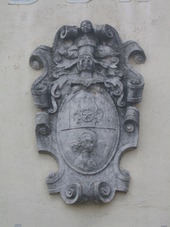to enlarge


or choose the place
from the menu below
 Rome |
 Byzantium |
 Venice |
 Vienna |
 Brioni |
 Smrikve |
 |
 |
The second copy of this important document, also written in glagolitic, was found in Krsan.
 Walking trough the village you will be impressed by the big stone coat of arms
of Rota’s family that was moved from the main entrance gates of the castle to the village.
Walking trough the village you will be impressed by the big stone coat of arms
of Rota’s family that was moved from the main entrance gates of the castle to the village.
Following the same road, you will arrive to the cross road that indicate that you are in the zone of important wine and olive oil trails. This region is particularly known for the high quality Muscat wine.
The top wine producers in the Momjan region are Armando and Franko Kozlovic, Marino Markezic - Kabola, Armando and Rino Prelac and Libero Sinkovic. Libero Sinkovic is also the owner of an agritourism San Mauro where you can taste traditional Istrian food.
Some of the most famous Momjan’s wine producers also produce some of the highest quality Istrian olive oil porducers, like Franko Kozlovic and Marino Markezic (Kabola). Another family in the same region that produce high quality olive oil is the family of Ivan Perossa. For those who like the taste of truffles, Konoba Marino and Konoba Rino are recommended.
There is an interesting story related with the marble from Kave village near Momjan. Istrian stone is famous all over the World and the most beautiful buildings in Venice have been built with it. In the Momjan region, not far away from Momjan, there is a small village called Kave famous for the fact that from this village the marble has been used for the interiors of the White House in Washington, for the State Opera in Vienna and for the Parliament building in Budapest.
In Momjan’s photo gallery you will find some pictures of the old Momjan’s castle and the places described above.
MOMJAN – HISTORICAL OVERVIEW
Momjan was named differently in its long history. We find the antique Latin name Mimilianum, later on Castrum Mamillanum and later on also Momiliano. In German it was named Momlan and also Mumian. Today it is named Momjan in Croatian and Momiano in Italian.
Momjan is mentioned for the first time as Villa in 1035. In 1102 was donated to the Aquileia Patriarchs by Istrian Marquis Ulrich II of Weimar. In 1208 the owner of Momjan was Vicardo and in 1230, Woscalus, son of Stephen of Duino.
Woscalus built the famous castle. His family, later on, were very influential in the region during the 13th century and were involved in various local battles between the Aquileia Patriarchs and the Counts of Gorizia.
It is known that in 1274 a son of Woscalus was killed by the rulers of Kostel and in the same year Counts of Duino allied with Counts of Gorizia conquered Kostel and killed the killer. Conone was the successor of Woscalus and his son Ulrich was the next ruler of Momjan.
In 1295 the castle turned back to the Aquileia Patriarchs due to the lack of successors. In 1313 Momjan passed to German family Raunicher. The area was after 1374 part of Austria and from 1508 part of Venice.
In 1548, family Raunicher sold Momjan to Simone Rota. Rota family lived in the castle until 1835 and than moved to their house in the village.
After the fall of the Venice Republic in 1797, Momjan passed to the Austrian Empire that later on transformed into the Austro-Hungarian Monarchy. It has also experienced a short period of Napoleonic rule. After the First World War, Momjan became part of Italy and after the Second World War it was part of Yugoslavia (Croatia).
During the Italian Fascist period in Istria many Istrian families suffered from the regime or had to leave Istria. Fascism in Istria applied various repressive measures mostly towards Slav populations and this created the Antifascist Movement. The Second World War was a very painful experience for the Istrian population and many innocent Istrians, both Slav and Latin, died during that war.
After the second World War Momjan became part of Yugoslavia (Croatia). There were three agreements between Yugoslavia and Italy which established that Istria would become a part of Yugoslavia: Paris Agreement of 1947, London Memorandum of 1954 and the Osimo Agreement reached in 1975.
In the first decade after the Second World War many Istrians, especially those living in towns and villages that for centuries were part of the Venice Republic, decided to leave Istria.